#kings of dál riata
Explore tagged Tumblr posts
Photo
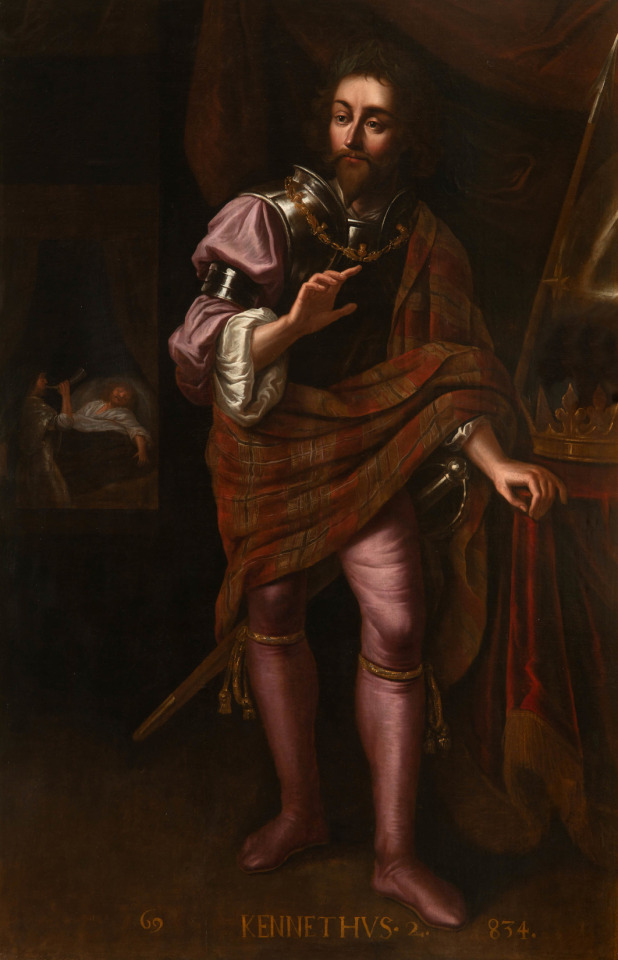
Legendary kings of Scotland by James de Witt.
69: Kennethus II (Kenneth MacAlpin)
Kenneth MacAlpin (810-858) or Kenneth I was King of Dál Riada (841–850), King of the Picts (843–858), and the first King of Alba (843–858) of likely Gaelic origin. He inherited the throne of Dál Riada from his father Alpín mac Echdach, founder of the Alpínid dynasty. Kenneth I conquered the kingdom of the Picts in 843–850 and began a campaign to seize all of Scotland and assimilate the Picts, for which he was posthumously nicknamed An Ferbasach ("The Conqueror"). Kenneth I is traditionally considered the founder of Scotland, which was then known as Alba, although like his immediate successors, he bore the title of King of the Picts. One chronicle calls Kenneth the first Scottish lawgiver but there is no information about the laws he passed.
#kingdom of scotland#kenneth macAlpin#king of scotland#alpínid dynasty#house of alpin#george buchanan#list of scottish kings#legendary kings of scotland#rerum scoticarum historia#list of monarchs#scottish history#kings of dál riata#Chronicle of the Kings of Dál Riata#kingdom of dalriada#kings of the picts#full-length portrait#full length portrait#Coinneach mac Ailpein#Cináed mac Ailpin
8 notes
·
View notes
Text

Causantín mac Cináeda (836-877). Engraved by I. Taylor.
#kingdom of scotland#Còiseam mac Choinnich#king contantin I#king of the picts#Pictish king#House of Alpin#Alpinid dynasty#Clann Chináeda#Clann Chinaeda meic Ailpín#Book of Ballymote#Dál Riata#kingdom of alba#Rìoghachd na h-Alba#engraving#Kinrick o Scotland#engravings#Kongungdum Skotland
3 notes
·
View notes
Text
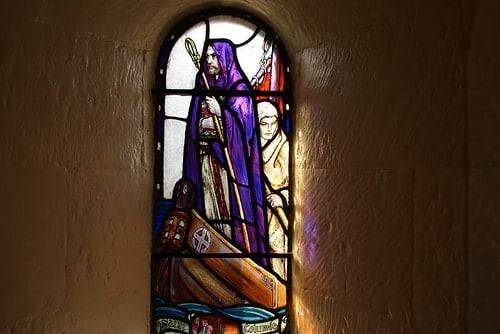
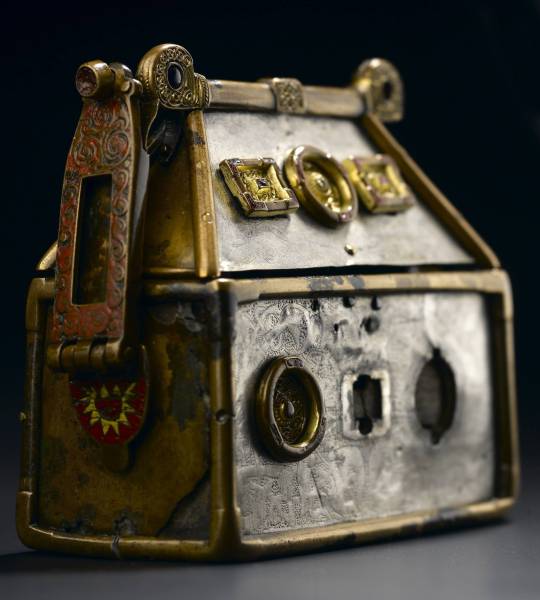
St. Columba was born in Donegal, Ireland on this day in 521AD.
Of all the Dark Age Scottish saints, Columba is the most spectacular star. In 563 AD he left Ireland and settled with the Gaels of Dál Riata, where he was granted the Island of Iona to found his monastery.
For the Gaelic warrior kings, Columba was a useful asset. His monastery provided education for their sons, he was a close advisor to the king, and he served as a diplomat to the king’s neighbours in Pictland and Ireland. Columba’s blessing was treasured by kings - a powerful symbol of their authority, and, in return for Columba’s support, the Gaels gave the monastery land and protection.
Columba died in 597, but his monastery’s influence continued to grow, leading to the foundation of new monasteries in Ireland and as far away as Lindisfarne in Northumbria. In Pictland, Columban monks began to spread the word of Christianity in the seventh century.
Iona faced competition from other Irish monastic missions, however, and their religious power was not absolute. St Mael Rhuba at Applecross or St Donnan, who was martyred on the Isle of Eigg, were also contenders as early spiritual leaders of the Church.
Columba himself would have remained an enigmatic and little-known figure were it not for Adomnán, the ninth Abbot of Iona, and his book, the Vita Colum Cille (Life of Columba), which ensured that the saint's reputation eclipsed that of the other Scottish saints and spread Iona’s fame across Christendom.
Pilgrimage to Iona increased: kings wished to be buried near to Columba, and a network of Celtic high crosses and processional routes developed around his shrine. At its zenith Iona produced The Book of Kells, a masterpiece of Dark Age European art. Shortly after however, in 794 AD, the Vikings descended on Iona, and, within 50 years, they had extinguished the light which had been Iona. Columba’s relics were finally removed in 849 AD and divided between Alba and Ireland.
The Monymusk Reliquary, seen in the second pic, from around 750 AD, probably contained a relic of St Columba. It became a powerful symbol of nationhood, and was carried before the Scots army as it marched into war.
This reliquary is thought to be the Brechbennoch which was carried by the Scots at the Battle of Bannockburn in 1314. If you are ever in the National Museum of Scotland, go see it.
The first pic shows Columba in a stained glass window at St Margarets Chapel at Edinburgh Castle.
22 notes
·
View notes
Text
Today, the Church remembers St. Columba, Abbott of Iona.
Ora pro nobis.
Saint Columba (Irish: Colm Cille, 'church dove'; Scots: Columbkille - 7 December 521 A.D. – 9 June 597 A.D.) was an Irish abbot and missionary credited with spreading Christianity in what is today Scotland at the start of the Hiberno-Scottish mission, which followed the migration of Northeastern Irish colonists to the west coast of Scotland, which had been going on for hundreds of years.
In early Christian Ireland, the druidic tradition collapsed due to the spread of the new Christian faith. The study of Latin learning and Christian theology in monasteries flourished. Columba became a pupil at the monastic school at Clonard Abbey, situated on the River Boyne in modern County Meath. During the sixth century AD, some of the most significant names in the history of Celtic Christianity studied at the Clonard monastery. The average number of scholars under instruction at Clonard was said to be 300. Columba was one of twelve students of St Finnian who became known as the Twelve Apostles of Ireland. He became a monk and eventually was ordained a priest.
In 563, he travelled to Scotland with twelve companions (said to include Odran of Iona) in a wicker currach covered with leather. According to legend he first landed on the Kintyre Peninsula, near Southend. However, being still in sight of his native land, he moved farther north up the west coast of Scotland. The island of Iona was made over to him by his kinsman Conall mac Comgaill King of Dál Riata, who perhaps had invited him to come to Scotland in the first place. However, there is a sense in which he was not leaving his native people, as the Ulster Gaels had been colonising the west coast of Scotland for the previous couple of centuries. Aside from the services he provided guiding the only centre of literacy in the region, his reputation as a holy man led to his role as a diplomat among the tribes.
There are also many stories of miracles which he performed during his work to convert the Picts, the most famous being his encounter with an unidentified animal that some have equated with the Loch Ness Monster in 565. It is said that he banished a ferocious "water beast" to the depths of the River Ness after it had killed a Pict and then tried to attack Columba's disciple named Lugne. He visited the pagan King Bridei, King of Fortriu, at his base in Inverness, winning Bridei's respect, although not his conversion. He subsequently played a major role in the politics of the country. He was also very energetic in his work as a missionary, and, in addition to founding several churches in the Hebrides, he worked to turn his monastery at Iona into a school for missionaries. He was a renowned man of letters, having written several hymns and being credited with having transcribed 300 books. One of the few, if not the only, times he left Scotland was towards the end of his life, when he returned to Ireland to found the monastery at Durrow.
Columba died on Iona and was buried in 597 AD by his monks in the abbey he created. In 794 the Vikings descended on Iona. Columba's relics were finally removed in 849 and divided between Scotland and Ireland. The parts of the relics which went to Ireland are reputed to be buried in Downpatrick, County Down, with Saint Patrick and Brigid of Kildare or at Saul Church neighbouring Downpatrick.
O God, by the preaching of your blessed servant Columba you caused the light of the Gospel to shine in Scotland: Grant, we pray, that, having his life and labors in remembrance, we may show our thankfulness to you by following the example of his zeal and patience; through Jesus Christ our Lord, who lives and reigns with you and the Holy Spirit, one God, forever and ever.
Amen.

4 notes
·
View notes
Text




I took another little jaunt today, this time up to Perthshire. Actually, mostly just Perth, but my first stop of the day was St Serf's Church in the village of Dunning for a look at the Dupplin Cross.
Now, Pictish cross-slabs are fairly commonplace; I'm unsure of the exact numbers involved here so I won't go as far as 'most', but they definitely make up a significant portion of surviving Pictish stones. Actual free-standing crosses, however, are rare. In fact, between deliberate damage inflicted during the Reformation and the general ravages of time, this might be the only one left; there's another one in Angus, but it's a late enough carving that it stands in a funny grey area between 'late Pictish' and 'early Scottish'. There are a few other mediaeval high crosses over in the west, on Iona for example, but I think they're more of a separate Gaelic tradition that owes more to Dál Riata and Ireland than Pictland.
Current thinking is that the stone was made for King Constantine of the Picts - not the Constantine who married King Rhun's sister, a different one. It was a popular name for Pictish/Scottish kings, so there have been a few of them. The rider on the shaft of the cross is thought to represent him, with his warriors parading on the next layer down.
1 note
·
View note
Text
Events 6.24 (before 1900)
1312 BC – Mursili II launches a campaign against the Kingdom of Azzi-Hayasa. 109 – Roman emperor Trajan inaugurates the Aqua Traiana, an aqueduct that channels water from Lake Bracciano, 40 kilometres (25 miles) northwest of Rome. 474 – Julius Nepos forces Roman usurper Glycerius to abdicate the throne and proclaims himself Emperor of the Western Roman Empire. 637 – The Battle of Moira is fought between the High King of Ireland and the Kings of Ulster and Dál Riata. It is claimed to be the largest battle in the history of Ireland. 843 – The Vikings sack the French city of Nantes. 972 – Battle of Cedynia, the first documented victory of Polish forces, takes place. 1128 – Battle of São Mamede, near Guimarães: Forces led by Afonso I defeat forces led by his mother Teresa of León and her lover Fernando Pérez de Traba. 1230 – The Siege of Jaén begins, in the context of the Spanish Reconquista. 1314 – First War of Scottish Independence: The Battle of Bannockburn concludes with a decisive victory by Scottish forces led by Robert the Bruce. 1340 – Hundred Years' War: Battle of Sluys: The French fleet is almost completely destroyed by the English fleet commanded in person by King Edward III. 1374 – A sudden outbreak of St. John's Dance causes people in the streets of Aachen, Germany, to experience hallucinations and begin to jump and twitch uncontrollably until they collapse from exhaustion. 1497 – John Cabot lands in North America at Newfoundland leading the first European exploration of the region since the Vikings. 1509 – Henry VIII and Catherine of Aragon are crowned King and Queen of England. 1535 – The Anabaptist state of Münster is conquered and disbanded. 1540 – English King Henry VIII commands his fourth wife, Anne of Cleves, to leave the court.[ 1571 – Miguel López de Legazpi founds Manila, the capital of the Philippines. 1593 – The Dutch city of Geertruidenberg held by the Spanish, capitulates to a besieging Dutch and English army led by Maurice of Nassau. 1604 – Samuel de Champlain encounters the mouth of the Saint John River, site of Reversing Falls and the present-day city of Saint John, New Brunswick, Canada. 1622 – Battle of Macau: The Dutch make a failed attempt to capture Macau. 1663 – The Spanish garrison of Évora capitulates, following the Portuguese victory at the Battle of Ameixial. 1717 – The Premier Grand Lodge of England is founded in London, the first Masonic Grand Lodge in the world (now the United Grand Lodge of England). 1724 – On the Feast of St. John the Baptist, Bach leads the first performance of his Christ unser Herr zum Jordan kam, BWV 7, the third cantata of his chorale cantata cycle. 1762 – Battle of Wilhelmsthal: The British-Hanoverian army of Ferdinand of Brunswick defeats French forces in Westphalia. 1779 – American Revolutionary War: The Great Siege of Gibraltar begins. 1793 – The first Republican constitution in France is adopted. 1812 – Napoleonic Wars: Napoleon's Grande Armée crosses the Neman river beginning the invasion of Russia. 1813 – Battle of Beaver Dams: A British and Indian combined force defeats the United States Army. 1821 – Battle of Carabobo: Decisive battle in the war of independence of Venezuela from Spain. 1859 – Battle of Solferino (Battle of the Three Sovereigns): Sardinia and France defeat Austria in Solferino, northern Italy. 1866 – Battle of Custoza: An Austrian army defeats the Italian army during the Austro-Prussian War. 1880 – First performance of O Canada at the Congrès national des Canadiens-Français. The song would later become the national anthem of Canada.
0 notes
Text
A rant against Karen Traviss' understanding of history and her FAQ answers
Did you base the Mandalorians on the Spartans?
<cite> No. I didn't. </cite> Fair enough.
<cite> I really wish history was taught properly - okay, taught at all - in schools these days, because history is the big storehouse that I plunder for fiction. It breaks my heart to hear from young readers who have no concept even of recent history - the last fifty years - and so can't see the parallels in my books. You don't have to be a historian to read my novels, but you'll get a lot more out of them if you explore history just a little more. Watch a history channel. Read a few books. Visit some museums. Because history is not "then" - it's "now." Everything we experience today is the product of what's happened before. </cite> Yeah, I do to. Please, Ms Traviss, go on, read some books. Might do you some good. And don't just trust the history channels. Their ideas about fact-checking differ wildly.
<cite> But back to Mandos. Not every military society is based on Sparta, strange as that may seem. In fact, the Mandos don't have much in common with the real Spartans at all. </cite> You mean apart from the absolute obsession with the military ["Agoge" by Stephen Hodkinson], fearsome reputation ["A Historical Commentary on Thucydides" by David Cartwright], their general-king ["Sparta" by Marcus Niebuhr Tod], the fact that they practically acted as mercenaries (like Clearch/Κλέαρχος), or the hyper-confidence ("the city is well-fortified that has a wall of men instead of brick" [Plutarch, Life of Lycurgus])...
<cite> A slightly anarchic, non-centralized, fightin' people? Sounded pretty Celtic to me. Since I went down that path, I've learned more about the Celts (especially the Picts), and the more I learn, the more I realise what a dead ringer for Mandos they are. But more of how that happened later... </cite>
The Celtic people are more than one people, more than one culture. Celtic is a language-family! In the last millennium BC nearly every European ethnic group was in some ways Celtic, and they were not one. Later, after the Germanic tribes (also not one people, or a singular group) moved westwards, the Celtic cultures were still counted in the hundreds. Not only Scotland was Celtic! Nearly all of Western Europe was (apart from the Greek and Phoenician settlers on the Mediterranean coasts). The word “Celts” was written down for the first time by Greek authors who later also used the word “Galatians”. The Romans called these people “Gauls”, and this word was used to describe a specific area, bordered by the Atlantic Ocean, the Cévennes and the Rhine: “Gaul”. So the Celts, the Galatians and the Gauls were all part of the same Celtic civilisation. "Celts, a name applied by ancient writers to a population group occupying lands mainly north of the Mediterranean region from Galicia in the west to Galatia in the east [] Their unity is recognizable by common speech and common artistic traditions" [Waldman & Mason 2006] Mirobrigenses qui Celtici cognominantur. Pliny the Elder, The Natural History; example: C(AIUS) PORCIUS SEVERUS MIROBRIGEN(SIS) CELT(ICUS) -> not just one culture "Their tribes and groups eventually ranged from the British Isles and northern Spain to as far east as Transylvania, the Black Sea coasts, and Galatia in Anatolia and were in part absorbed into the Roman Empire as Britons, Gauls, Boii, Galatians, and Celtiberians. Linguistically they survive in the modern Celtic speakers of Ireland, Highland Scotland, the Isle of Man, Wales, and Brittany." [Celtic Culture: a historical encyclopedia. by John Koch] "[] the individual CELTIC COUNTRIES and their languages, []" James, Simon (1999). The Atlantic Celts – Ancient People Or Modern Invention. University of Wisconsin Press. "All Gaul is divided into three parts, one of which the Belgae live, another in which the Aquitani live, and the third are those who in their own tongue are called Celtae, in our language Galli." [Julius Caesar, De Bello Gallico] <= I had to translate that in school. It's tedious political propaganda. Read also the Comentarii and maybe the paper "Caesar's perception of Gallic social structures" that can be found in "Celtic Chiefdom, Celtic State," Cambridge University Press. The Celtic tribes and nations were diverse. They were pretty organized, with an academic system, roads, trade, and laws. They were not anarchic in any way. They were not warriors - they were mostly farmers. The Celts were first and foremost farmers and livestock breeders
The basic economy of the Celts was mixed farming, and, except in times of unrest, single farmsteads were usual. Owing to the wide variations in terrain and climate, cattle raising was more important than cereal cultivation in some regions.
Suetonius addressing his legionaries said "They are not soldiers—they're not even properly equipped. We've beaten them before." [not entirely sure, but I think that was in Tacitus' Annals]
Regarding the Picts, in particular, which part of their history is "anarchic"? Dál Riata? the Kingdom of Alba? Or are you referring to the warriors that inspired the Hadrian's Wall? Because no one really knows in our days who the fuck they were. The Picts’ name first appears in 297 AD. That is later. <cite> Celts are a good fit with the kind of indomitable, you-can't-kill-'em-off vibe of the Mandos. Reviled by Rome as ignorant savages with no culture or science, and only fit for slaughter or conquest, the Celts were in fact much more civilized than Rome even by modern standards. </cite> That's how the Romans looked at pretty much every culture that wasn't Greek, Roman, Phoenician, Egyptian, or from Mesopotamia (read, if you want, anything Roman or Greek about the Skyths, the Huns, Vandals, Garamantes...).
<cite> They also kicked Roman arse on the battlefield, and were very hard to keep in line, so Rome did what all lying, greedy superpowers do when challenged: they demonized and dehumanized the enemy. (They still used them in their army, of course, but that's only to be expected.) </cite> They were hard to keep in line, but they most definitely did not kick Roman arse on the battlefield. Roman arse was kicked along the borders of the Roman Empire, such as the Rhine, the Danube, the Atlas mountains, etc. And mostly by actually badly organized, slightly anarchic groups, such as the Goths or the Huns (BTW the Huns were not a Germanic people, even though early 20th century British propaganda likes to say so). Though they were also decisively stopped by the Parthians. Who were very organized. Ah well. <cite> While Rome was still leaving its unwanted babies to die on rubbish dumps - a perfectly acceptable form of family planning to this "civilisation" - and keeping women as chattels devoid of rights, the barbarian Celts had a long-standing legal system that not only gave women what we would think of as equal rights, but also protected the rights of the elderly, children, and the disabled. They had a road network across Europe and worldwide trade long before the Romans ever got their act together. And their science - well, their astronomical calculations were so sophisticated that it takes computers to do the same stuff today. </cite> See? You even say yourself that they weren't actually anarchic. Also you're not completely right: 1. women (of most Celtic cultures, with one notable exception being the Irish) were not allowed to become druids, e.g. scientists, physicians, priests, or any other kind of academics, so they did not have equal rights. Also, as in other Indo-European systems, the family was patriarchal. 2. the roads they had were more like paths, and did not span the entirety of Europe; the old roads that are still in use are nearly all of them Roman. Had the Celtic inhabitants of Gallia or Britannia built comparable roads, why would the Romans have invested in building a new system on top? 3. world-wide? Yeah, right. They traded with those who traded with others and so were able to trade with most of southern Eurasia and northern Africa, as well as few northern parts (Balticum, Rus), but that's (surprise) not the whole world. 4. most people use computers for those calculations you mention because its easier. It's not necessary. I can do those calculations - give me some time to study astronomy (I'm a math major, not physics) and some pencils and paper. 5. and - I nearly forgot - the kids didn't die. That was a polite fiction. The harsh truth is that most Roman slaves were Romans... <cite> So - not barbarians. Just a threat to the empire, a culture that wouldn't let the Pax Romana roll over it without a fight. (Except the French tribes, who did roll over, and were regarded by the Germanic Celts [...]) </cite> WTF Germanic Celts? What are you smoking, woman? Isn't it enough that you put every culture speaking a language from the Celtic family in one pot and act as if they were one people, now you have to mix in a different language-family as well? Shall we continue that trend? What about the Mongolian Celts, are they, too, proof that the Celts were badass warriors? I think at this point I just lost all leftover trust in your so-called knowledge. <cite> [...] as being as bad as the Romans. Suck on that, Asterix... </cite> Asterix was definitely a Celt, and unlike the British Celts, he was not a citizen of the Roman Empire.
<cite> Broad brush-stroke time; Celts were not a centralized society but more a network of townships and tribes, a loose alliance of clans who had their own internal spats, but when faced with some uppity outsider would come together to drive off the common threat. </cite> They might have tried, but they didn't. The first and only time a Celtic people really managed to drive off some uppity outsider would be 1922 following the Anglo-Irish Treaty of 1921*. The fact that France, Spain, Portugal speak Romance languages and the British (or Irish) Isles nearly uniformly speak English should be proof enough.
*Unless you count Asterix. <cite> You couldn't defeat them by cutting off the head. There was no head to cut off. </cite> You mean unlike Boudica and Vercingetorix. Oh wait. Tacitus, in his Annals, said that Boudica's last fight cost 80,000 Britons and 400 Romans their lives. He was probably exaggerating. But it definitely stopped much of the British resistance in its tracks. <cite> To the centralized, formal, rather bureaucratic Romans, for whom the city of Rome was the focus of the whole empire, this was a big does-not-compute. The Celts were everything they didn't understand. And we fear what we don't understand, and we kill what we fear. </cite> While that is totally true, it's also completely off the mark. The Romans demonized the druids, not every Celt, and they were afraid of what was basically an academic network. That had nothing to do with war. <cite> Anyway, Mandos....once I took a single concept - in this case, the idea of clans that operated on a loose alliance system, like the Celts - the rest grew organically. I didn't plan it out in detail from the start. </cite> That's really obvious. Maybe looking at some numbers and remembering that you weren't planning a small, local, rural, medieval community would have helped, too. I mean lets have a look at, say, Scotland (since you specifically mentioned the Picts): they still have less than 6 mio. people all together, and that's today. Mandalore is a sector. A sector of Outer Space with at least 2000 inhabited planets. How do you think that translates? It doesn't. <cite> I just asked myself what a culture of nomadic warriors would value, how they would need to operate to survive, and it all grew inexorably by logical steps. The fact that Mandos ended up as very much like the Celts is proof that the technique of evolving a character or species - find the niche, then work out what fits it - works every time. It creates something very realistic, because that's how real people and real societies develop. </cite> Celtic people were usually not nomadic! And, once again, non of them were predominantly warriors! It's really hard to be a nomadic farmer. I believe the biggest mistake you made, Ms Traviss, is mixing up the Iron Age (and earlier) tribes that did indeed sack Rome and parts of Greece, and that one day would become the people the Romans conquered. And apart from the Picts they really were conquered. <cite> So all I can say about Mandos and Spartans is that the average Mando would probably tell a Spartan to go and put some clothes on, and stop looking like such a big jessie. </cite>
I'd really like to see a Mando – or anyone – wearing full plate without modern or Star Wars technology in Greece. Happy heatstroke. There is a reason they didn't wear a lot (look up the Battle of Hattîn, where crusaders who didn't wear full helmets and wore chainmail* still suffered badly from heat exhaustion). [Nicolle, David (1993), Hattin 1187: Saladin's Greatest Victory] *chainmail apparently can work like a heatsink CONCLUSION You're wrong. And I felt offended by your FAQ answers. QUESTION You're English. You're from England. A group - a nation - that was historically so warlike and so successful that by now we all speak English. A nation that definitely kicked arse against any Celtic nation trying to go against them (until 1921, and they really tried anyway). A nation that had arguably the largest Empire in history. A nation that still is barbaric and warlike enough that a lost football game has people honestly fearing for their lives.
Also, a Germanic group, since you seem to have trouble keeping language-families and cultures apart. If we were to talk about the family, we could add on the current most aggressively attacking nation (USA) plus the former most aggressively attacking nations (the second and third German Reich), also the people who killed off the Roman Empire for good (the Goths and Visigoth), the original berserkers (the Vikings) and claim at the very least the start of BOTH WORLD WARS. Why did you look further?
Some other sources:
Histoire de la vie privée by Georges Duby and Philippe Ariès, the first book (about the antiquity) I read it translated, my French is ... bad to non-existent
The Day of the Barbarians: The Battle That Led to the Fall of the Roman Empire (about the Huns) by Alessandro Barbero
If you speak Dutch or German, you might try
Helmut Birkhan: Kelten. Versuch einer Gesamtdarstellung ihrer Kultur, Verlag der Österreichischen Akademie der Wissenschaften, Wien
Janssens, Ugo, De Oude Belgen. Geschiedenis, leefgewoontes, mythe en werkelijkheid van de Keltische stammen. Uitgeverij The House of Books
DISCLAIMER
I’m angry and I wrote this down in one session and thus probably made some mistakes. I’m sorry. Or maybe I’m not sorry. I’m still angry. She can’t know who reads her FAQ and at least two of her answers (on her professional website) were offensive to the reader.
#history#england#scotland#ancient celts#roman empire#mandalorians#sparta#proud warrior race#shitty research#rant#me ranting#fuck this#karen traviss
83 notes
·
View notes
Text
The Nature and Extent of Irish Raids on Britain after the Retreat of Rome
Some basic background: The Roman Empire had been waning in Britain for hears and finally retreated for good in 407 AD. When Rome first conquered Britain, they of course couldn't allow them to retain an independent army, which risked revolt. Rome was their army. When Rome left the Britons were left with their warrior caste carved out of society. Laws set by the Romans had prohibited the natives from bearing arms at all outside of the military. This ban was lifted in 410 AD when Emperor Honorius told the British cities to "look after themselves." Britain was now ruled by local princes, who often petitioned Rome for military aid, begging for help against encroaching invaders. Saxons from the East, Picts from the North, and the Irish from the West, each as vicious as the other.
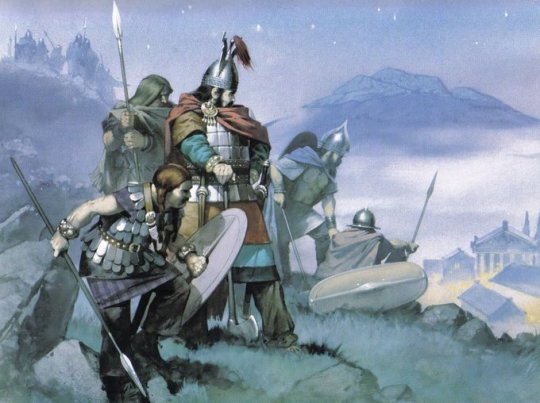
That is no exaggeration. We often play up the power of the Saxon at the expense of the others. Roman writer Ammianus Marcellinus called the raids a conspiratio barbarica, and the Annals record almost as many Irish and Pictish raids as Saxon ones. Outside the reach of Rome, men were still wild.
The five kingdoms of Ireland (cóiceda) were fighting amongst themselves, but like the Norwegians centuries later, internal conflict never deterred expansion. The most Irish-afflicted areas of Britain were the south west of Wales (Pembrokeshire, a.k.a. Dyfed), Cornwall (Dumnonnia), and Argyll (Dál Riata). How extensive were these raids? They were settlements. The ruling dynasty of Dyfed came from Leinster. Many places such as Dyfed or Lleyn were bilingual with Gaelic, at least among the nobility. Many ogham stones from this area (the most in all of Britain) are written in Gaelic, not Brythonic. Many place names in Wales to this day derive from Irish or reference Ireland, such as Llyn Iwerddon, "Lake of Ireland", in Caernarvonshire. Another is Dolwyddelan (Dole-with-eh-lahn), which derives from Gwyddelan and Gwyddel, which is a Welsh term for a Gael or Goidel. Many such terms. A Welsh poet might call another poet's work "diseisnig" and "diwyddelig", that is, untainted by English or Irish. But make no mistake, the Irish in the end left no major genetic impression on the Welsh population. In this instances it was merely a temporary occupation of the upper classes by nobles funded by Irish kings.
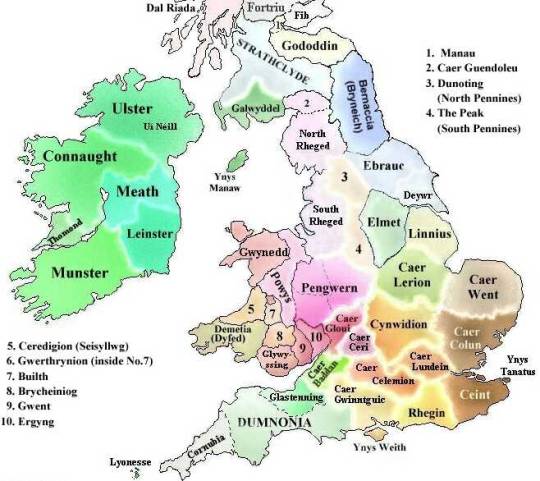

The raids of the Irish did not begin once the Romans left. It was continuous, and the Romans and Welshmen had previously constructed defensive forts at Caerleon and Caerwent, and later at Cardiff. A fort at Segontium was used to guard the Roman copper mines on Ynys Mona from the Irish raiding parties. Nonetheless the Irish broke through once Rome left. Cormac's Glossary tells us the following:
"The power of the Irish over Britain was great, and they divided Britain between them into estates... and the Irish lived as much east of the [Celtic] sea as they did in Ireland... and their dwellings and their royal fortresses were made there. Hence Dind Tradui... the triple rampart of Crimthann Mór, son of Fidach, king of Ireland and Britain as far as the English Channel... and they were in control for a long time, even after the coming of Patrick."
Now what could this mean, that the Irish lived as must east of the sea as west? Perhaps the Britons, like the Picts under the Gaels and the East Britons under Saxons, began to call themselves "Irish", while maintaining a Welsh underground identity. We have to remember that after Britain had been militarily and culturally dominated by Rome, it was easy for barbarians to impress a new culture onto the Britons. The Romano-Britons spoke Latin (mostly) and wanted to have Roman culture, but this was a one-sided and unstable relationship ripe for replacement with a nearer culture.
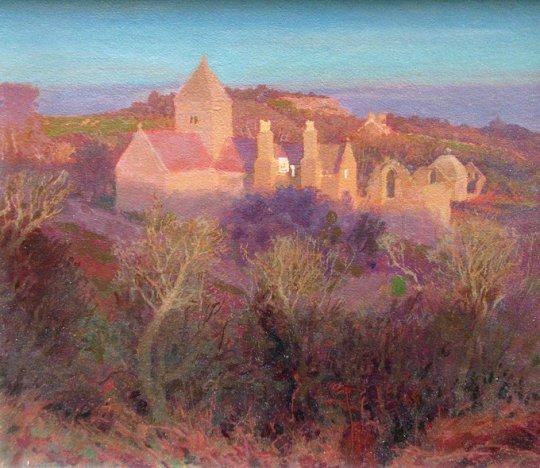
The territories of Devon and Lancashire were strongholds against the encroaching Irish powers, stopping the Gael from traveling further inland or northward. The threat of an Adventus Scottorum kept the western kings awake at night. The Severn Sea (modern Bristol Channel) was the stage for major Irish settlement into Devon. Linguistic and historical evidence shows that most of the Britons who fled to Brittany originated in Devon, contrary to Gildas' accounts of Central and Eastern Wales. The traditional narrative of Saxon invaders forcing the Britons of the Welsh Marches across the sea can't be true. The Armorican migration was occurring in the 4th, 5th, and 6th centuries, but Saxon power hadn't reached Wales until the after the Battle of Mount Badon c. 500. Yet the Roman Armoricans had begun allying with and giving land to immigrant Bretons in 409 AD, to bolster their numbers against a continental Saxon scare. The eastern Anglo-Saxons could not have been the cause of the Breton migration, but the western Irish were. The Irish settlements and raids on the Cornish coast of the Severn Sea depopulated the area of its inhabitants. When the Anglo-Saxons reached the area, there were no Celts to retain place names, hence the strange preponderance of English toponymy in Devon.
North Wales and Cumbria (Rheged) formed twin kingdoms to repel Irish and Saxon raids. The south called Deheubarth meaning "the Right Hand", and the north called Gwyr y Gogledd meaning "the Left Hand." These brother peoples often relied heavily on each other for defense.

The Irish settlement of Argyll and the surrounding Isles left a much more distinct genetic and cultural mark. The raiders into Argyll and Galloway established the kingdom of Dál Riata, with its power center at the modern ruins of Dunolly Castle at Oban, and it's monastery at Iona. Before the invasions into Argyll in the 5th century, all of Alba was ruled by Picts and Pictish families. In the East, Picts ruled until the 9th century. The "Picts" (which is a Latin name) likely called themselves Cruithni, and spoke a maybe-not-Indo-European tongue, though it had much in common with Brythonic. The conquest of Pictland began when King Fergus Mór and his two brothers led a fleet of 150 men to conquer a number of Western Scottish Isles. They set up their clifftop fortress at the Rock of Dunadd, and expanded eastward from there. The next great King was Aedán Mac Gabráin, who went out to conquer the Orkneys, Hebrides, and all of mainland Scotland as far as Perthshire. These maps don't really show it, but Aedán won a battle in the Orkneys against a Pictish King in 580 AD and won. Dál Riata was powerful. A few generation after the death of Aedán, the Dál Riatic Kingdom was starting to conquer or merge with the Eastern Pictish kingdoms to form the modern kingdom of Scotland. Aedán's immediate successor, Eochaid Buide, was already called "Rex Pictorum.” Irish Gaelic (which would morph into Scots Gaelic) was the language of the royal courts in Pictland, and eventually trickled down to the lower classes, as languages usually do. Folklore also spread from Ireland into Pictland; Scottish folklore today is from the same root as Irish. And although the Ulster Irish kings left a large genetic mark on the western highlands and Galloway, the main expansion of the Irish was political, linguistic, and cultural, adopted by the Picts or Britons from above.
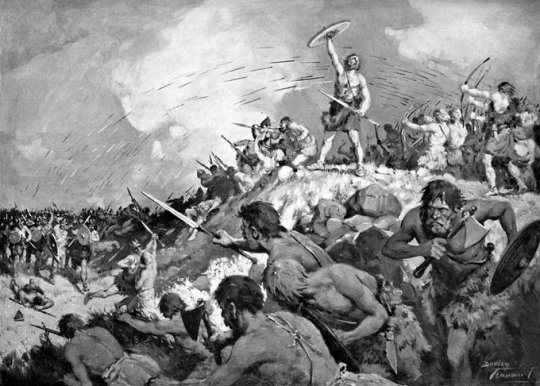
Infighting between the Ulaid dynasty within Ulster, along with later Viking maritime power, eventually severed the Scottish Gaels from the Irish Gaels, and Dál Riata was free to focus its attention on uniting Scotland against Vikings and Bernicians. And for some reason, the Irish raiders never had much interest in Rheged. It was left mostly untouched, even in the early days. Though today this area has a strange preponderance of Scandinavian place names instead of Saxon ones. This is because in 902, the Irish Kings repelled the Vikings from Dublin, who then migrated across the sea into Cunbria and Rheged. So there was no difficulty in physically going there, but for some reason the Irish didn't.
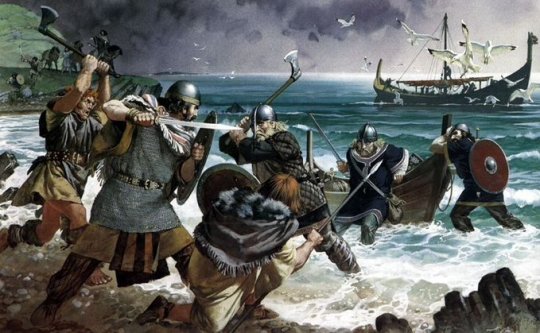
#britain#ireland#history#irish history#raids#celtic history#anglo-saxon#welsh#wales#briton#medieval#dark age#vikings#celts#celtic#irish#english#england#saxon#british history
13 notes
·
View notes
Photo
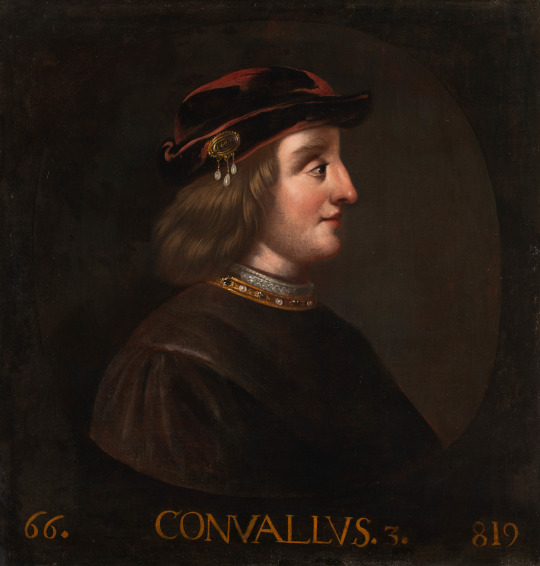
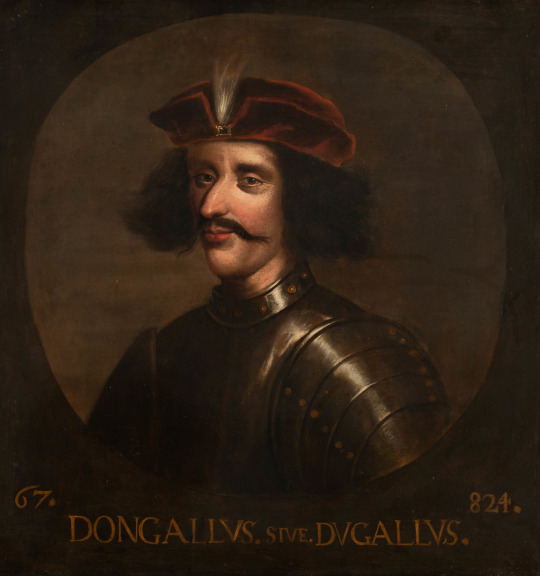
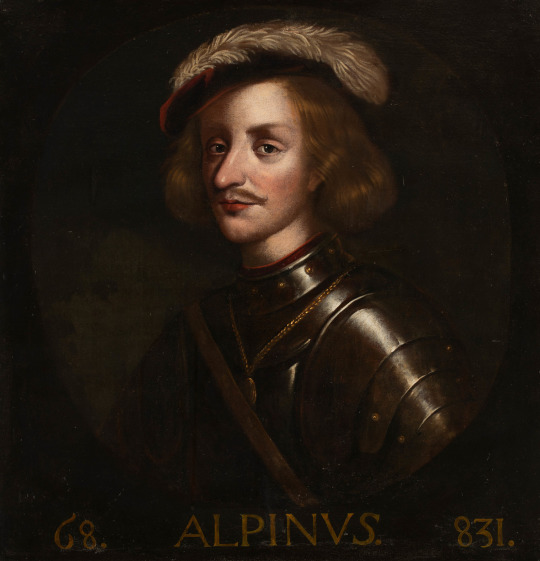
Legendary Kings of Scotland by James de Witt.
66: Congallus III or Convallus II (Conall Crandomna). He was king of Dál Riata (modern western Scotland) from about 650 until 660. The Senchus fer n-Alban (an Old Irish medieval text) makes him a son of Eochaid Buide and thus a member of the Cenél nGabráin. He was co-ruler with Dúnchad mac Conaing until 654, after which he was apparently sole ruler. His sons Máel Dúin mac Conaill and Domnall Donn may have been kings of Dál Riata. His death in 659 or 660 is reported by the Annals of Ulster.
67: Dongallus (Domangart mac Domnaill). It is not clear whether he was king of Dál Riata or king of the Cenél nGabráin (the Cenél nGabráin was a kingroup, presumed to descend from Gabrán mac Domangairt, which dominated the kingship of Dál Riata until the late 7th century and continued to provide kings thereafter.)
68: Alpinus (Alpín mac Echdach). Cináed and Alpín are the names of Pictish kings in the 8th century: the brothers Ciniod and Elphin who ruled from 763 to 780. Weir states that Alpín succeeded his father Eochaid IV as King 'of Scotland' (Dál Riata), and also became King of Kintyre in March/August 834, thus establishing his power over a wide area of Scotland. Alpín died on 20 July or in August 834 when he was either killed whilst fighting the Picts in Galloway or beheaded after the battle. His place of burial is not recorded. He was succeeded by his son Kenneth MacAlpin.
#Conall Crandomna#dongallus#domangart mac domnaill#alpinus#alpin mac echdach#legendary kings of scotland#george buchanan#jacob jacobsz de wet ii#list of scottish kings#list of monarchs#rerum scoticarum historia#scottish history#de iure regni apus scotos#Chronicle of the Kings of Dál Riata#kings of dál riata#kingdom of dalriada#kings of the picts#scottish dna
6 notes
·
View notes
Photo





So, before we fully face The Wrath of the Droods, let’s go into the customization options.
First off is the “Celtic Hair”. Now, that style isn’t anything like what you’d really expect to see at the time in medieval Ireland, as I’ve gone over in the past, the style was very much for elaborately curled hair, not necessarily that kind of ratty bun style, though there were variations. For the ladies, we have a wonderful description from the 12th century Togail Bruidne Dá Derga, or “The Destruction of Da Derga’s Hostel”: “On her head were two golden-yellow tresses, in each of which was a plait of four locks, with a bead at the point of each lock.” Likewise in the 9th century Cath Maige Tuired, “As he went along he saw a girl in front of him, a good-looking young woman with an excellent figure, her hair in beautiful tresses.”
So, from what we can gather, the style at the time was very much for tresses.

This style that Eivor can wear is probably more similar to what a ninth century Irish woman would wear, ironically enough.
There’s no reference to Lugh wearing blue paint........at all in the myths. Lugh does plenty of strange things, that’s not one of them.
The Dal Riata set is very obviously referencing stereotypes about the Picts, who, in the popular imagination (though not necessarily accepted by modern Pictish scholars) depicted as naked people wearing tattoos, as shown in this 16th century engraving by John White.

You can see even see the same sun symbolism between the two of them.
Now, it’s interesting that it’s called “Dál Riata” as opposed to “Pictish”, because the Dál Riata started out, initially, as Irish settlers in Scotland (there was also an Irish Dál Riata), and they often feuded with their Pictish neighbors, the Picts conquering the Dál Riata under King Onuist in the 8th century. Modern scholarship seems to suggest that the Dál Riata remained subordinate kings, but that the Picts did not outwardly hold the kingship of Dál Riata. (Though, frankly, as an Irish scholar, I’m going to be the first to say that the Picts are NOT my specialty and kind of scare me as a subject.)
By the 8th century, outward Pictish symbolism fell out of style on monuments, as noted by Juliana Grigg in The Picts Re-Imagined, pg. 92, replaced by angels and apostles. Pictish culture wasn’t exterminated, but it adapted to a more tumultuous time, with the Norse invasions, like elsewhere, forcing them to change with the times.
And the Druid tattoo is...well. All I need to say is that those are RUNES on the stomach, not ogham, and that kind of says everything. I’ll note that the phases of the moon are there and that’s.............in line with the Roman accounts that describe the druids as astronomers and great teachers, albeit a very new agey way of going about it. And, of course, no one would put a tattoo of a necklace on your collarbone, what are you, a peasant? Get yourself a real golden necklace, you cheapskate. (There are....no references to body markings in medieval Ireland, at least that I know of.)
7 notes
·
View notes
Text


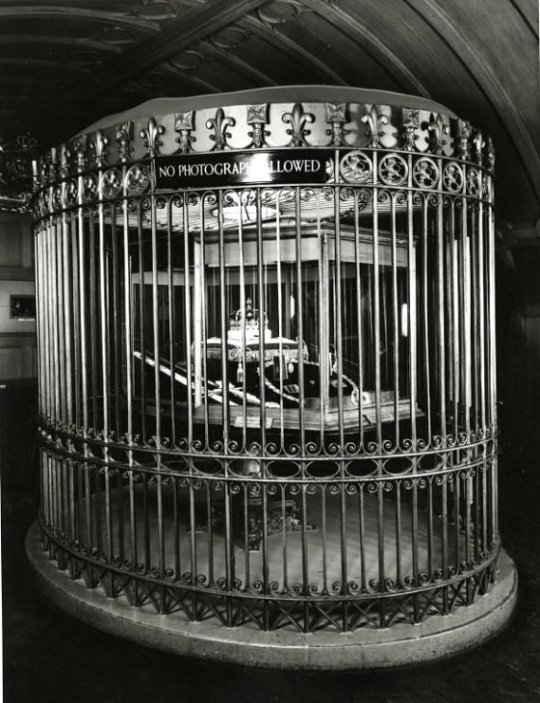

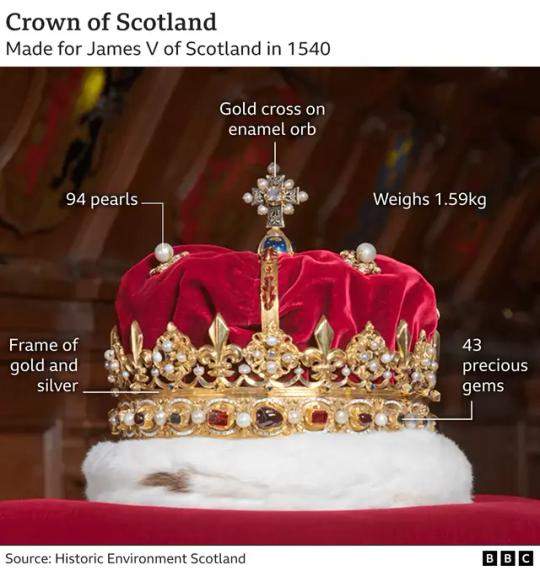
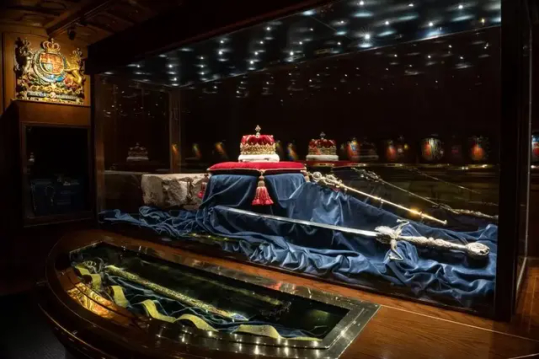
On 26th May 1819, the Honours went on public display in the Crown Room in Edinburgh Castle.
The ‘Honours’, our Crown Jewels, were first used together at the coronation of the nine-month-old Mary, Queen of Scots in 1543, the Crown almost certainly dates from before 1540 when it was remodelled by order of James V. It was last worn at the coronation of Charles II at Scone in 1651, the last time a monarch was crowned in Scotland.
Made of solid silver, the Sceptre is surmounted with three figures supporting a crystal globe, a cut and polished rock crystal, with a Scottish pearl on top. A gift from the Pope, possibly given by Innocent Vlll to James IV in 1494, again it was remodelled by James V who even added his initials to the sceptre, the Stewarts were a vain lot.
The Sword of State was presented to James IV in 1507 by Pope Julius II and has a blade a metre long.
Following the Treaty of Union in 1707, the ancient Honours were not seen for a century. Rumours circulated that the English had removed them to London. However Sir Walter Scott asked for permission to seek them out in in 1818. And as he suspected they were found in a chest hidden away.
They have remained on secure display ever since, except for the duration of World War II.
The Honours have since been joined by other royal regalia and jewels of a personal nature – the Wand (found in the Chest in 1818), the Stewart Jewels (presented by William IV in 1830) and the Lorne Jewels (bequeathed by Princess Louise in 1939) – and by the Stone of Destiny (see separate Statement), which was returned from Westminster Abbey in 1996 after it as stolen by Edward I (Longshanks) Scotland ove700 years before.
Below is a lengthy rundown of the Honours as marked down in history, please note though that the earliest dates are only noted in history some of the original Honours were lost by the English.
574: First reference to a royal sceptre, by Cumméne ‘the White’, seventh abbot of Iona, in connection with the inauguration by St Columba of Aédán mac Gabhráin as king of the Scots of Dál Riata.
1097: King Edgar is depicted on his seal wearing a crown, and holding a sceptre and sword.
1157: David I is depicted in a posthumous charter holding an orb in place of a sceptre.
1182: William I ‘the Lion’ is presented with a golden rose by Pope Lucius II.
1296: Edward I of England strips John I (Balliol) of his crown, sceptre and sword and takes them, together with the Stone of Destiny, to England, where they are subsequently lost or destroyed.
1306: Robert I (Bruce) is enthroned at Scone with a new circlet of gold.
1329: Pope John XXII formally recognises the right of kings of Scots to be formally crowned and anointed, hitherto denied them on account of English opposition.
1331: David II, Robert I’s heir, is formally crowned and anointed at Scone.
1484: Coin evidence (a silver groat) indicates that the crown, hitherto a simple open circlet, has by now become an ‘imperial’ crown (ie, closed with arches).
1486: James III is presented with a golden rose by Pope Innocent IV.
1491: James IV is presented with a golden rose by Pope Innocent VIII.
1494: Tradition has it that the Sceptre was presented to James IV by Pope Alexander VI. However, it is possible that the Sceptre was presented with the golden rose in 1491.
1503: James IV is depicted in the Book of Hours , made to commemorate his marriage, wearing an ‘imperial’ crown. Also, first mention of a crown bonnet.
1507: The Sword of State is presented to James IV by Pope Julius II. A consecrated, or blessed, hat is presented at the same time.
1532: The bonnet is renewed and the crown repaired by Thomas Wood, goldsmith.
1536: The Sceptre is lengthened and embellished for James V by Adam Leys, an Edinburgh goldsmith, perhaps in preparation for his first marriage, to Princess Madeleine de Valois. This enhancement is formally acknowledged when the Crest above the Royal Arms is amended, the Sceptre replacing the Saltire in the lion’s left paw.
1539, the crown is refashioned to its present form for James V by John Mosman, Edinburgh goldsmith. James wears it for the first time at the coronation of his second wife, Mary of Guise, in Holyrood Abbey. The purple velvet bonnet, made by Thomas Arthur, has not survived, but its four delicate ornaments have.
1543: Mary Queen of Scots is crowned in Stirling Castle, the first sovereign to be enthroned with all three Honours. 1
560: Queen Mary receives a golden rose from Pope Pius IV. 1567: James VI is crowned with the Honours in the Kirk of the Holy Rude, Stirling.
1571–73: Substitute Honours are used at sittings of Parliament, because Edinburgh Castle is in the hands of the supporters of the exiled Queen Mary.
1615–16: The Crown Room is created, part of the wholesale remodelling of the Palace in preparation for James VI’s ‘hamecoming’ in 1617. The present Crown Chest is very probably also made at this date.
1633: Charles I is crowned in Holyrood Abbey with the Honours
1638–39: The Honours are taken to Dalkeith Castle for safe-keeping during the conflict between Charles I and those supporting the National Covenant.
1650: The Honours are removed from the castle, possibly to Stirling Castle, for safe-keeping, prior to Oliver Cromwell besieging the castle.
1651: Charles II is crowned with the Honours at Scone. Following the ceremony, the Honours, unable to be brought back to Edinburgh Castle, are taken to mighty Dunnottar Castle, Kincardineshire, seat of the Earl Marischal.
1652–60: The Honours are smuggled out of Dunnottar and buried under the floor of nearby Kinneff Kirk. On Charles II’s return to the throne, the Honours are returned to Edinburgh Castle: all except the Sword belt and Crown cushion.
1687: James VII has the crown bonnet changed from purple to red.
1707: Following the adjourning of Parliament after the passing of the Act of nion.
1790: The Sword Belt is discovered hidden in a wall at Barras, near Dunnottar Castle, by Sir David Ogilvy.
1794: Lieutenant-Governor Major Drummond briefly opens the Crown Room in search of old Parliamentary records but, because he lacks the necessary royal warrant, does not break open the Crown Chest.
1818: Walter Scott and others, with a royal warrant from the Prince Regent, officially break into the Crown Room, break open the Crown Chest and there rediscover the Honours, together with a wand, or baton of office. A second royal warrant appoints the Commissioners for the Keeping of the Regalia (Keeper of the Great Seal, Keeper of the Privy Seal, His Majesty’s Advocate, the Lord Clerk Register and the Lord Justice Clerk). Scott’s friend Adam Ferguson is appointed Keeper of the Regalia, with a ‘grace and favour’ flat above the Crown Room.
1819: The public are invited to inspect the Honours in the Crown Room, on payment of an admission fee.
1822: George IV (the former Prince Regent) formally visits Scotland, and the Honours are taken to the Palace of Holyroodhouse for the duration of his stay.
1830: The Stewart Jewels, bequeathed to George III in 1807 by Prince Henry, Cardinal York, the last Stuart claimant to the throne of Great Britain, are entrusted by William IV into the safe-keeping of the Keeper of the Regalia for display in the Crown Room.
1837: The Turkish Ambassador is denied entry to the Crown Room because he does not have an admission ticket!
1842: The Honours are temporarily removed to an adjacent room so that they may be better viewed by Queen Victoria and Prince Albert.
1848: The present panelling is installed in the Crown Room by the Edinburgh firm of Charles Trotter, cabinetmakers and joiners.
1871: The Honours are redisplayed behind a cage of ornamental bars, for their better security.
1892: The Sword Belt is returned to the Crown Room from Barras Castle, Kincardineshire, by Rev. Samuel Ogilvy Baker, a descendant of Sir David Ogilvy.
1905: The old Crown Cushion is presented to the State by Sir Patrick Keith Murray, who states that it had been retained at Dunnottar by his ancestor, Sir William Keith, 9th Earl Marischal, after the Honours had been smuggled out in 1652
1911: The Sword is taken to St Giles’ Cathedral for the official opening of the Thistle Chapel. Gyp, the Crown Room dog, dies and is buried in the Dog Cemetery below St Margaret’s Chapel.
1939: Princess Louise, Queen Victoria’s fourth daughter, bequeaths the Lorne Jewels, presented to her by Clan Campbell on the occasion of her marriage to the Marquis of Lorne in 1871, to the Scottish nation, and they are added to the display in the Crown Room. Shortly thereafter (1 September), the Crown Jewels are taken down to the basement of the Palace to protect them from aerial bombardment by German planes.
1942: The Honours are secretly taken out of the basement and buried in David’s Tower, where they remain for the duration of WWII.
1953: The Honours are presented to Her Majesty Queen Elizabeth at the National Service of Thanksgiving in St Giles’ Cathedral that follows the Coronation in Westminster Abbey.
1971: The Sword of State is used for the first time at the ceremonial installation of a Knight of the Most Ancient and Most Noble Order of the Thistle, Scotland’s premier Order of Chivalry, held in the Thistle Chapel, in St Giles’ Cathedral.
1980s: The post of Warden of Regalia is abolished. 1
987: The Sword of State is used alone for the final time, in St Giles’ Cathedral for the tercentenary anniversary celebrations of the Order of the Thistle. Thereafter, in view of its parlous condition, its ceremonial role is restricted to National Services of Thanksgiving
1993: Her Majesty Queen Elizabeth formally opens the Honours of the Kingdom exhibition, including the extensively refurbished Crown Room and redisplayed Honours. The present Crown Cushion is made specially for the occasion. The Crown Chest is relocated from the Crown Room to an adjacent exhibition space and displayed alongside one of the original padlocks, broken in 1818.
1999: The Crown is formally taken to the State Opening of the Scottish Parliament, the first in the modern era.
2022; The Crown of Scotland was placed on Elizabeth II's coffin at a service in St Giles' Cathedral.
2023; The Honours of Scotland were presented to King Charles III in a ceremony held in St Giles' Cathedral. The ceremony was formally described as a National Service of Thanksgiving and Dedication to mark the coronation of King Charles III.
39 notes
·
View notes
Text
arthurian names #1: arthur
hi everybody, i was thinking of doing a weekly activity of sorts on this blog where i take a proper name from arthurian legend and do a little write up on it, talk about etymology, history, variants, etc etc. i think this would be a fun combination of two of my special interests, arthuriana and onomastics, and i know people like it when i talk about arthurian names so! this is just a little test run to see how it goes :) for this series of posts i will stay factual and keep personal opinions to a minimum. so starting off with the original himself, we’ll do arthur first.
history: first appears in the historia brittonum under ‘arthur’, dating from 829, but, if not a later interpolation, most earliest mention may be in y gododdin dating from anywhere from the 7th to 11th century. the most notable earliest use of it as a personal name for real people was artuir mac áedán, son of áedán mac gabráin, a prince of dál riata living between the 500s-600s. it is by far the most popular arthurian name in both the middle ages and the modern day, used by real people even earlier than its use for the fictitious king. (see eg withycombe’s entry for arthur in his dictonary of english christan names)
etymology: debated. a widely accepted theory seems to be from the roman gens artorius, with the latin name (possibly of a celtic origin itself) being re-adapted to the brittonic arthur/arzhur of the welsh and breton languages (see kemp malone’s article artorius). another proposed etymology is that it is from the welsh arth (bear) + (g)wr (man), but due to various phonological reasons, this does not make sense-arthur is never rendered as arthwr in welsh, and is always rhymed with other -ur words as opposed to -wr words (note: the u in welsh is pronounced differently than the u in english, and considering the name arthur in its original language automatically rules out any question of the latter half of the name being derived from gwr.)
this does not, however, mean that arthur cannot be derived from the proto brittonic arth (bear), and other proposed etymologies including the artorius hypothesis and another proposing it is a corrupted version of arcturus (the latin variant of arthur is arturus) all end up being derived from a word for bear (albeit in differing languages) so it is probably safe to assume that the bear meaning is related to arthur’s name.
various variants: arthur (various, english, welsh, modern french), arturus (latin) arturo (various, spanish, italian) artur (various, dutch, german, norwegian) artu (old french), artos (tagalog), ארתור (hebrew), arzhur (breton)
#finny.txt#arthuriana#king arthur#arthurian legend#onomastics#arthurian onomastics#<- thatll be my tag for it#IF YOU DONT LIKE THIS..YELL AT ME AB IT IDK
7 notes
·
View notes
Text
Events 6.24
1312 BC – Mursili II launches a campaign against the Kingdom of Azzi-Hayasa. 109 – Roman emperor Trajan inaugurates the Aqua Traiana, an aqueduct that channels water from Lake Bracciano, 40 kilometres (25 miles) northwest of Rome. 474 – Julius Nepos forces Roman usurper Glycerius to abdicate the throne and proclaims himself Emperor of the Western Roman Empire. 637 – The Battle of Moira is fought between the High King of Ireland and the Kings of Ulster and Dál Riata. It is claimed to be the largest battle in the history of Ireland. 843 – The Vikings sack the French city of Nantes. 972 – Battle of Cedynia, the first documented victory of Polish forces, takes place. 1128 – Battle of São Mamede, near Guimarães: Forces led by Afonso I defeat forces led by his mother Teresa of León and her lover Fernando Pérez de Traba. 1230 – The Siege of Jaén begins, in the context of the Spanish Reconquista. 1314 – First War of Scottish Independence: The Battle of Bannockburn concludes with a decisive victory by Scottish forces led by Robert the Bruce. 1340 – Hundred Years' War: Battle of Sluys: The French fleet is almost completely destroyed by the English fleet commanded in person by King Edward III. 1374 – A sudden outbreak of St. John's Dance causes people in the streets of Aachen, Germany, to experience hallucinations and begin to jump and twitch uncontrollably until they collapse from exhaustion. 1497 – John Cabot lands in North America at Newfoundland leading the first European exploration of the region since the Vikings. 1509 – Henry VIII and Catherine of Aragon are crowned King and Queen of England. 1535 – The Anabaptist state of Münster is conquered and disbanded. 1540 – English King Henry VIII commands his fourth wife, Anne of Cleves, to leave the court. 1571 – Miguel López de Legazpi founds Manila, the capital of the Philippines. 1593 – The Dutch city of Geertruidenberg held by the Spanish, capitulates to a besieging Dutch and English army led by Maurice of Nassau. 1604 – Samuel de Champlain discovers the mouth of the Saint John River, site of Reversing Falls and the present-day city of Saint John, New Brunswick, Canada. 1622 – Battle of Macau: The Dutch make a failed attempt to capture Macau. 1663 – The Spanish garrison of Évora capitulates, following the Portuguese victory at the Battle of Ameixial. 1717 – The Premier Grand Lodge of England is founded in London, the first Masonic Grand Lodge in the world (now the United Grand Lodge of England). 1762 – Battle of Wilhelmsthal: The British-Hanoverian army of Ferdinand of Brunswick defeats French forces in Westphalia. 1779 – American Revolutionary War: The Great Siege of Gibraltar begins. 1793 – The first Republican constitution in France is adopted. 1812 – Napoleonic Wars: Napoleon's Grande Armée crosses the Neman river beginning the invasion of Russia. 1813 – Battle of Beaver Dams: A British and Indian combined force defeats the United States Army. 1821 – Battle of Carabobo: Decisive battle in the war of independence of Venezuela from Spain. 1859 – Battle of Solferino (Battle of the Three Sovereigns): Sardinia and France defeat Austria in Solferino, northern Italy. 1866 – Battle of Custoza: An Austrian army defeats the Italian army during the Austro-Prussian War. 1880 – First performance of O Canada at the Congrès national des Canadiens-Français. The song would later become the national anthem of Canada. 1894 – Marie François Sadi Carnot, President of France, is assassinated by Sante Geronimo Caserio. 1913 – Greece and Serbia annul their alliance with Bulgaria. 1916 – Mary Pickford becomes the first female film star to sign a million-dollar contract. 1918 – First airmail service in Canada from Montreal to Toronto. 1922 – The American Professional Football Association is renamed the National Football League. 1932 – A bloodless revolution instigated by the People's Party ends the absolute power of King Prajadhipok of Siam (now Thailand). 1938 – Pieces of a meteorite land near Chicora, Pennsylvania. The meteorite is estimated to have weighed 450 metric tons when it hit the Earth's atmosphere and exploded. 1939 – Siam is renamed Thailand by Plaek Phibunsongkhram, the country's third prime minister. 1940 – World War II: Operation Collar, the first British Commando raid on occupied France, by No 11 Independent Company. 1943 – US military police attempt to arrest a black soldier in Bamber Bridge, England, sparking the Battle of Bamber Bridge mutiny that leaves one dead and seven wounded. 1947 – Kenneth Arnold makes the first widely reported UFO sighting near Mount Rainier, Washington. 1948 – Cold War: Start of the Berlin Blockade: The Soviet Union makes overland travel between West Germany and West Berlin impossible. 1949 – The first television western, Hopalong Cassidy, starring William Boyd, is aired on NBC. 1950 – Apartheid: In South Africa, the Group Areas Act is passed, formally segregating races. 1954 – First Indochina War: Battle of Mang Yang Pass: Viet Minh troops belonging to the 803rd Regiment ambush G.M. 100 of France in An Khê. 1957 – In Roth v. United States, the U.S. Supreme Court rules that obscenity is not protected by the First Amendment. 1960 – Assassination attempt of Venezuelan President Rómulo Betancourt. 1963 – The United Kingdom grants Zanzibar internal self-government. 1973 – The UpStairs Lounge arson attack takes place at a gay bar located on the second floor of the three-story building at 141 Chartres Street in the French Quarter of New Orleans, Louisiana, US. Thirty-two people die as a result of fire or smoke inhalation. 1975 – Eastern Air Lines Flight 66 encounters severe wind shear and crashes on final approach to New York's JFK Airport killing 113 of the 124 passengers on board, making it the deadliest U.S. plane crash at the time. This accident led to decades of research into downburst and microburst phenomena and their effects on aircraft. 1981 – The Humber Bridge opens to traffic, connecting Yorkshire and Lincolnshire. It remained the world's longest bridge span for 17 years. 1982 – "The Jakarta Incident": British Airways Flight 009 flies into a cloud of volcanic ash thrown up by the eruption of Mount Galunggung, resulting in the failure of all four engines. 1989 – Jiang Zemin succeeds Zhao Ziyang to become the General Secretary of the Chinese Communist Party after the 1989 Tiananmen Square protests and massacre. 1994 – A Boeing B-52 Stratofortress crashes at Fairchild Air Force Base near Spokane, Washington, killing four. 1995 – Rugby World Cup: South Africa defeats New Zealand and Nelson Mandela presents Francois Pienaar with the Webb Ellis Cup in an iconic post-apartheid moment. 2002 – The Igandu train disaster in Tanzania kills 281, the worst train accident in African history. 2004 – In New York, capital punishment is declared unconstitutional. 2010 – At Wimbledon, John Isner of the United States defeats Nicolas Mahut of France, in the longest match in professional tennis history. 2010 – Julia Gillard assumes office as the first female Prime Minister of Australia. 2012 – Death of Lonesome George, the last known individual of Chelonoidis nigra abingdonii, a subspecies of the Galápagos tortoise. 2013 – Former Italian Prime Minister Silvio Berlusconi is found guilty of abusing his power and engaging in sex with an underage prostitute, and is sentenced to seven years in prison. 2021 – The Champlain Towers South condominium in Surfside, Florida suffers a sudden partial collapse, killing 98 people inside. 2022 – In Dobbs v. Jackson Women's Health Organization, the U.S. Supreme Court rules that the U.S. Constitution does not assign the authority to regulate abortions to the federal government, thereby returning such authority to the individual states. This overturns the prior decisions in Roe v. Wade (1973) and Planned Parenthood v. Casey (1992).
0 notes
Text

a brief history on the homelands of ser mordred. (historical canon mixed with the undertones of arthurian legend.)
𝑻𝑯𝑬 𝑫𝑬𝑺𝑪𝑬𝑵𝑫𝑬𝑵𝑻𝑺 𝑶𝑭 𝑽𝑶𝑻𝑨𝑫𝑰𝑵𝑰 - GODODDIN
the kingdom of lothian sat within the lands of yr hen ogledd (the old north) as a barrier between the midlands of england and the pictlands to the north. it incorporated most of northern england and southern scotland; though bordered the kingdom of strathclyde on the east which remained the land of the gaels. the people who lived in yr hen ogledd were known as gododdin, descendents of the votādīnio--a celtic iron age people. in the early 5th century, some one hundred years before mordred was born, din eidyn (edinburgh) became the capital of of the votadini and their descendents. eidyn remained the significant power in the old north until the 7th century. here they spoke a language known as cumbric; an early form of scots. these peoples were often considered as savages from the angles and the saxons south of the border of the gododdin due to their natures of living. they survived upon the lands and worshipped their pagan gods, they often fought wars with other clans in the nearby areas over land or otherwise personal matters. however, the people of the old north and the picts and gaels that bordered them all shared the same sentiment of protecting the right to their lands. the kingdom of alba was often a notion toyed with amongst the council of clans, but to settle peace between the families would require more than talks.
𝑫𝑰𝑵 𝑬𝑰𝑫𝒀𝑵 - THE HOME OF CLAN LOTH
the land of alba possessed a tribal culture, a home to many peoples of vaguely differing celtic cultures. the votadini to the south, the dál riata to the north west, and the picts to the north and the east. the votadini were of a pictish sort. the clan lothian resided in the northernmost area of the old north, possessing major lands upon the coast of the sea of iudeu, now the firth of forth. the clan of loth lived in a settlement upon castle rock in eidyn.
𝑻𝑯𝑬 𝑲𝑰𝑵𝑮𝑫𝑶𝑴 𝑶𝑭 𝑩𝑬𝑹𝑵𝑰𝑪𝑰𝑨 - INVADERS FROM THE SOUTH
the kingdom of bernicia was an anglo-saxon kingdom established in the 6th century upon the eastern coasts of the old north. the anglian settlers were ruled by a man named ida, who pushed his people further north to claim the lands of the gododdin and wiping out the people and the culture in the process. the angles, working with the saxon invaders from the south, eventually pushed their way towards east lothian. though they did not claim the lands of lothian and of the old north until much later, their power upon lothian borders destabilised the kingdom of lothian as a whole. in the middle sixth century, it became desperate for king loth to reach out in search for allies.
𝑻𝑯𝑬 𝑲𝑰𝑵𝑮𝑫𝑶𝑴 𝑶𝑭 𝑪𝑨𝑴𝑬𝑳𝑶𝑻 - THE ROUND TABLE
king loth eventually sent his sons to join the knights of the round table, south of bernician lands, in a desperate attempt to form a strong alliance against the saxons and angles. although camelot had lost most of its celtic ways to the angles and the romans, the idea of bonding the kingdoms of albion together was the best idea to search for peace. although varying clans upon the lands of hen ogledd aligned themselves with king arthur, the bernician people did not. the anglo-saxons of bernicia attempted to push both north and south to expand their borders, and the knights of lothian assisted the kingdom of camelot and the other kingdoms across the land to push them back.
𝑻𝑯𝑬 𝑩𝑨𝑻𝑻𝑳𝑬 𝑶𝑭 𝑪𝑨𝑻𝑹𝑨𝑬𝑻𝑯 - BORDERS TO THE SOUTH
the people of lothian, as well as a majority of people from clans across the lands of alba and the old north, fought alone in catraeth on the southern borders of what was now the bernician kingdom--land that once belonged to the gododdin. the gododdin-lead assault failed, and nearly all of them were killed. the anglo-saxons reigned victorious in catraeth. mordred had originally requested assistance from camelot and the knights of the round table in fighting this war upon voltadini lands to reclaim them under the kingdom of lothian. king arthur deigned not to assist. the amount of lives that were lost during this battle weighed heavily upon mordred’s heart and the heart of his father, who was already weakening from old age. the loss of lives also put eidyn in a risky position, and eventually, the anglo-saxons were able to push into and claim east lothian.
𝑻𝑯𝑬 𝑩𝑨𝑻𝑻𝑳𝑬 𝑶𝑭 𝑪𝑨𝑴𝑳𝑨𝑵𝑵 - THE BETRAYAL
the battle of camlann was centred on the western coast of the old north, at the farthest reaches of gododdin territory. here, king arthur lead the knights of the round table into battle against the anglo-saxons that threatened to move south into the territories of camelot and the surrounding areas. mordred fought alongside arthur during this battle by the edge of hadrian’s wall, until nearly all of the saxons were slain and the territory was reclaimed. arthur attempted to take the territory in the name of camelot, though it rightfully belonged to the gododdin. after the loss of warriors amongst the clans of his homeland thanks to king arthur’s neglect, the loss of his own father’s territory in lothian, amongst many other things in relation to camelot’s attacks upon the druids in Dál Riata and the massacre of magic users the old north as a whole, mordred turned on arthur as they stood side by side on the battlefield. they slew each other amongst the corpses.
𝑻𝑯𝑬 𝑲𝑰𝑵𝑮𝑫𝑶𝑴 𝑶𝑭 𝑵𝑶𝑹𝑻𝑯𝑼𝑴𝑩𝑹𝑰𝑨 - THE AFTERMATH
after mordred and arthur had been slain, the anglo-saxons of bernicia were able to take lands further. they allied with their southern neighbour, the kingdom of deira to claim the capital of lothian. the clan lothian was completely wiped out and the castle came under anglo-saxon rule. the kingdom of northumbria was formed here, which incorporated a third of the lands of albion as a whole and blocked the picts from the south of england and wales. they bordered the kingdom of strathclyde, unable to penetrate beyond hadrian’s wall. the surving gododdin in lothian escaped north into pict territory, where they eventually formed a force so great that they were able to reclaim eidyn from the angles some hundred years later.
#slam dunks this onto the dash#notes 【 𝑳𝑶𝑹𝑬 】 ❝ there is no more desperate creature than a humanbeing on the verge of losing love .
11 notes
·
View notes
Text
Orkney in my Arthuriana
So here is how I am thinking of the Orkney situation in my Arthuriana.
Traditionally Lot is King of Orkney. And Lothian. And Norway. In the earliest texts, Geoffey, Wace, Layamon, he is King of Lothian and inherits Norway from his uncle Sichelm. The King of the Orkneys is a fellow named Gunfasius.
Yet I think beginning in Boron Lot becomes King of Orkney. Gunfasius thus disappears from following Arthuriana. In Vulgate Lot rules Orkney (quite amusingly it is referred to as a city, I kind of doubt the French authors knew much of British geography).
So I was thinking of a meta-version of this in my version of events.
In Geoffrey there are three brothers who rule Albany between them, Auguselus, King of Albany, Urien, of Moray, and Lot, the ‘Duke’ of Lothian. Auguselus fades out of Arthuriana a bit, in some versions getting conflated with Anguish of Ireland possibly. Urien and Lot are no longer brothers. Urien is King of Gorre, or former ruler of Gorre before passing it to his nephew Bagdemagus. Following Arthuriana is complicated.
And the historical figures they were based on were not brothers, Geoffrey just made them so, sucking in history and mingling it into Arthuriana, as we all do.
Anyway, Urien was a historical figure, the King of Rheged, son of Cynfarch Oer. So what I am thinking is Cynfarch was a very ambitious man, interested in expanding his dominions and becoming the main power in Albany.
Due to a disputed succession in Orkney (think like after Alexander III of Scotland’s death) Cynfarch tries to seize power there, against a kinsman. To help his bid for power he marries a Norwegian Princess, but it is agreed a son from this union must be given Orkney. Which happens. (I go with Lot being half-brother as some accounts say the King of Norway had no other heirs save Lot, possibly to make Arthur look more legitimate in helping his brother-in-law. Well, uncle by marriage as in some accounts the Anna Lot is married to is Uther’s rather then Arthur’s sister. Anyway this would be odd with Lot having brothers so I imagine they are half-brothers.)
Auguselus, due to his father’s planning, is able to establish himself as King of Albany. As he may have been based on a ruler of Argyll I imagine his power base is there (mayhaps he married a Dál Riata Princess. His mother could be from the ruling House of Argyll.).
As for Urien his father is able to get him Gorre, having his daughter marry Tadus, from one of the most powerful Houses in Gorre for alliance. After Urien resigns the Kingdom he grants the eldest son of that union, Bagdemagus, rule of Gorre. He then heads North and is granted Rheged and Moray by his elder brother Auguselus.
But what of Orkney?
Lot has also been given Lothian by his father. (In Tysilio he has Lindsey but meh. And in Boece he’s the King of the Picts.) However there are some who think his family are not the rightful holders of authority in Orkney.
Enter Gunfasius. He believes his claim is better. Think of him like... the Florents to the Tyrells in ASOIAF. He is one of the most powerful Lords in Orkney. While he does not openly fight Lot, he remains as a potential threat. Lot cannot just eliminate him because that would make him look bad and likely trigger a rebellion from local nobles. Lot already has problems trying to hold onto another Kingdom.
In Malory two Knights are mentioned, “Then came therein two brethren, cousins unto Sir Gawaine, the one hight Sir Edward, that other hight Sir Sadok, the which were two good knights; and they asked of King Arthur that they might have the first jousts, for they were of Orkney. I am pleased, said King Arthur. Then Sir Edward encountered with the King of Scots, in whose party was Sir Tristram and Sir Palomides; and Sir Edward smote the King of Scots quite from his horse”.
I imagine these are Gunfasius’ sons. They were formerly kept as h̶o̶s̶t̶a̶g̶e̶s̶ squires by Lot. After he was beaten Arthur decided to take them as h̶o̶s̶t̶a̶g̶e̶s̶ squires to his court.
And the little detail Edward smote the King of Scots? Might be Auguselus, a little dig from his family at Lot’s family. Though I imagine the term Scots will be a bit more loaded. The people of Dál Riata are Scots, being descended from settlers from Scotia, now called Ireland, a son of an Irish King, Fergus, was the first King of Scotland.

Mostly the land is referred to as Albany, but the Scots are one of the mightiest forces there, under Goranus for much of Arthur’s reign. Then there’s Eugenius... but that’s another story.
As for the tensions between Gunfasius and Lot Arthur sees how to solve it. Gunfasius is more of a pragmatist. Like his father Lot likes prestige and grandeur. Just like Auguselus has the title King of Albany but in reality can’t really hold power over all of it. So he suggests while Lot is away Gunfasius be Steward of Orkney. Which is agreed to. As for Morgause she is asked to act in a Regent’s role in Lothian. She might bear Mordred on Orkney but she does more of her abuse in Lothian. (I imagine at times her family is more frightened of her then Gunfasius because abusive relatives are the worst. And she frightens Gunfasius and the people of Orkney more then any of her family.)
There could be some humour in pointing out Lothian is more populated and nicer then Orkney so why does Lot put all this effort into holding onto it? But nobles like titles. Dinaden might make a jibe about it as he seems the sort who would.
Also Lot’s uncle dies and he and Arthur fight to get some Norwegian lands from Riculf, who takes the Kingship. But a younger son of Aschil, King of Denmark, takes some Norwegian lands. This is due to Odbrict, King of Norway, suddenly turning up in end of Arthur section of Geoffrey. Also it’s a ref to Haakon VII of Norway, second son of heir to Danish throne, who was chosen as new King of Norway when his great-uncle Oscar II of Sweden renounced the throne of Norway in 1905.
Gunfasius continues to scheme. He has one of the best knowledges of lineages in all Britain... naturally due to his claim to Orkney meaning you have to go back some generations. He and Eugenius at times may plot together, Eugenius agreeing when he becomes King he would ‘recognise’ Gunfasius if they ever made a bid for the throne.
Gawain, being a friendly sort, gets on well with his distant cousins. They don’t have to feud because their fathers do.
However, for some reason, Edward predeceases his father, leaving a son, also called Gunfasius. Sadok joins Lancelot and the last reference to him in Malory says that when Lancelot is giving out lands to his followers “Sir Sadok he gave the Earldom of Surlat” (which seems to be a south-west commune Sarlat-la-Canéda).
Lot’s line, due to the fighting, are much diminished. He has a grandson still living... in Constantinople, so Cligès won’t be contesting Orkney.
Sadok gets the Earldom and considers contesting his nephew Gunfasius the Younger for Gunfasius the Elder’s lands. But he decides not to risk an Earldom in nicer lands anyway for Kingship of Orkney. He also sees the consequences of family splits.
So Gunfasius becomes King of Orkney. As a result of confused identification later accounts act as if Gunfasius was King of Orkney for more of Arthur’s reign.
And that is the Orkney situation!
If you got through you will realise Arthuriana is very complicated and alters round. And don’t try to think too hard about this and history. I gave up long ago.
@blackcur-rants @cukibola @epic-summaries
#arthuriana#my arthuriana#gunfasius#king lot#how many lands do gawains family have#eugenius iii#king arthur#orkney clan#auguselus#urien#arthuriana is complicated#matter of britain
20 notes
·
View notes
Photo
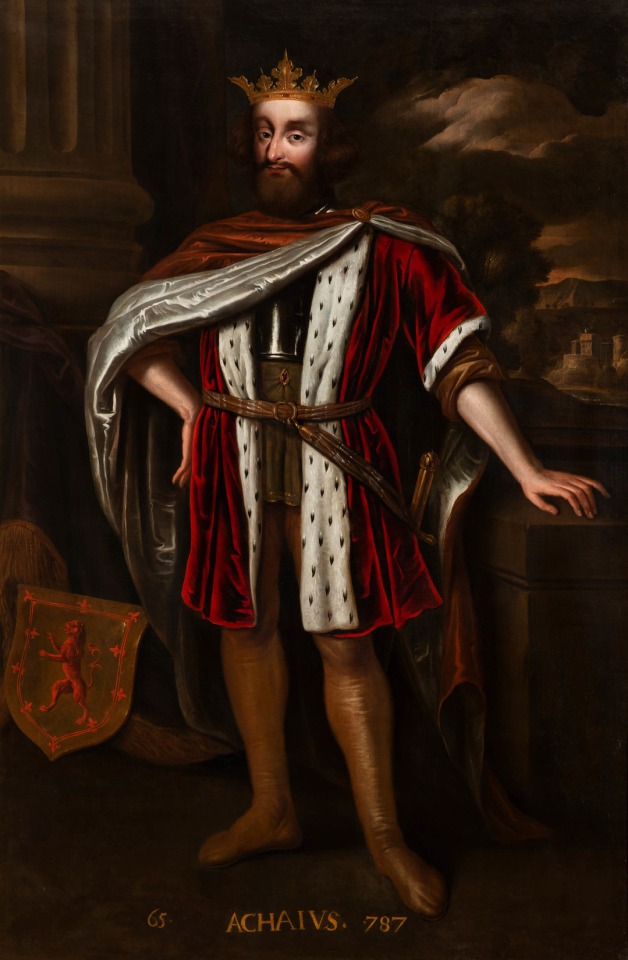
Legendary Kings of Scotland:
65: Achaius (Eochaid mac Áeda Find).
Eochaid mac Áeda Find is a supposed King of Dál Riata found in some rare High Medieval king-lists and in older history books. Supposedly a son of Áed Find (died 778) and successor to Áed's brother Fergus mac Echdach. Also supposed to have concluded a treaty with the Emperor Charlemagne.
#kingdom of scotland#kingdom of dalriada#jacob jacobsz de wet ii#james de witt#full-length portrait#george buchanan#full length portrait#legendary kings of scotland#scottish dna#achaius#eochaid mac áeda find#list of scottish kings#rerum scoticarum historia#de iure regni apus scotos#kings of dál riata#Chronicle of the Kings of Dál Riata#kings of the picts
5 notes
·
View notes